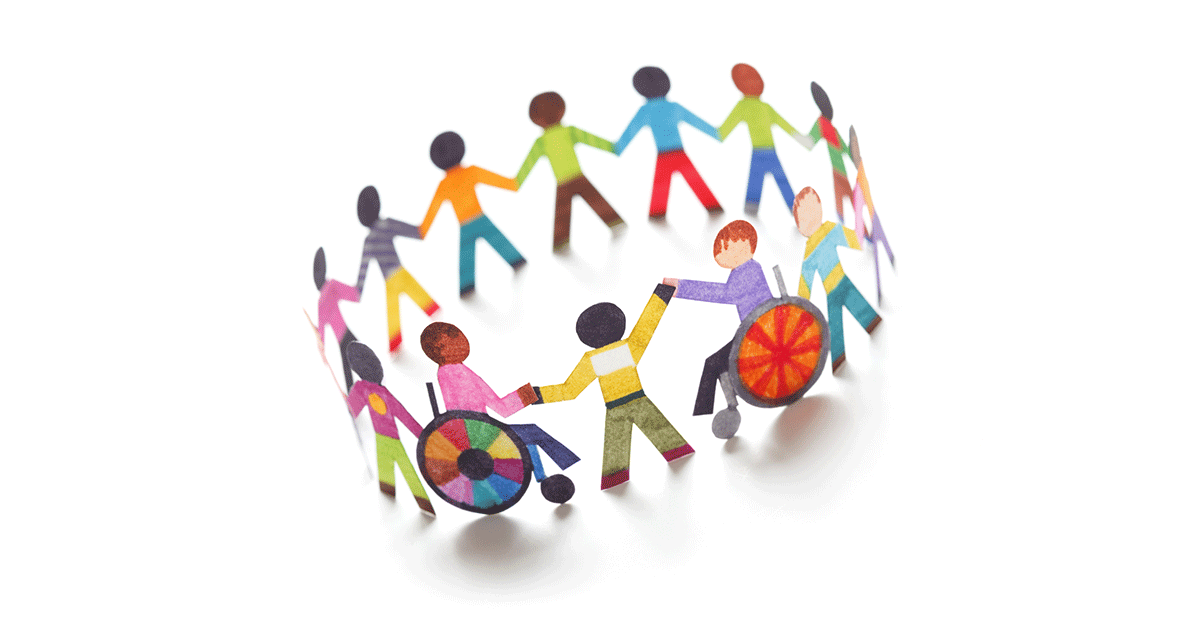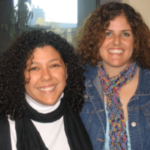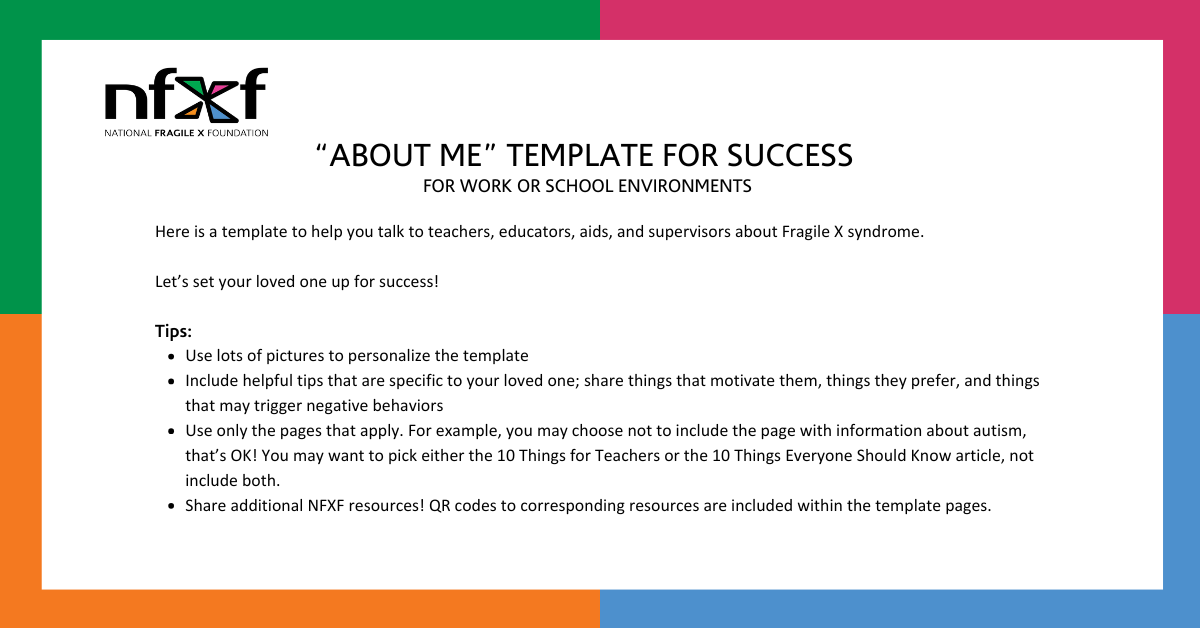IN PROGRESS!
This article was adapted and updated from an original article by Laura Greiss Hess and Kerrie Lemons Chitwood.
Making Sense of Special Education Alphabet Soup
- Just like all other children, students with special needs have the right to a FAPE.
- Schools must consider teaching a child with special needs in the LRE whenever possible.
What? Here’s the above in English:
- Just like all other children, students with special needs have the right to a free and public education.
- Schools must consider teaching a child with special needs in the least restrictive environment whenever possible.
Here we cover the following “alphabet soup” acronyms and abbreviations (not necessarily in this order):
- AT = Assistive Technology
- AAC = Augmentative and Alternate Communication
- IDEA = Individuals with Disabilities Education Act
- IEP = Individualized Education Program
- IFSP = Individualized Family Service Plan
- FAPE = Free and Appropriate Public Education
- LRE = Least Restrictive Environment
- LSH = Language, Speech, Hearing Specialty
- OT = Occupational Therapy
- SI = Sensory Integration
- SLP = Speech-Language Pathology (or Pathologist)
- ST = Speech Therapy (or Therapist)
What is IDEA?
IDEA = Individuals with Disabilities Education Act
IDEA is the federal law that makes early intervention and special education available for students with special needs.
IDEA stands for the Individuals with Disabilities Education Act, the federal law that provides early intervention and special education for students with special needs.
What is FAPE?
FAPE stands for free appropriate public education. This is central to the federal law IDEA and is a protected right of children eligible for special education. Just like all other children, students with special needs have the right to a free public education.
What is LRE?
LRE stands for least restrictive environment and means that schools must consider teaching a child with special needs in general education whenever possible.
There is a continuum of “restrictiveness” ranging from the most restrictive of residential placements, to special education centers where all children on the campus have special needs, to special education classrooms on general education campuses, to resource-style classes where students spend parts of a day in special education and parts of the day in general education plus full inclusion in general education settings. The graphic is a representation of “restrictiveness.”
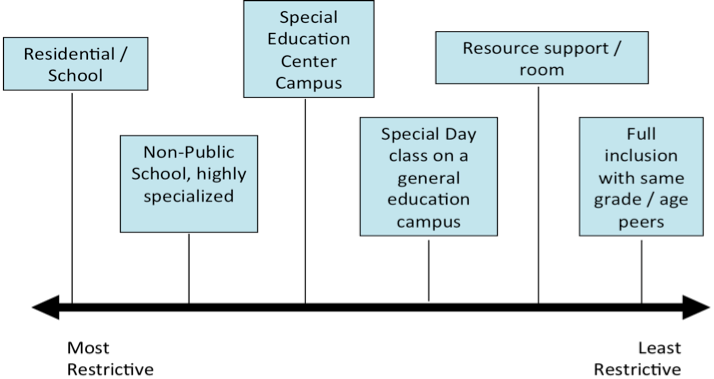
What is an IEP?
IEP stands for individualized education program and is a written document for each child with a disability. It is developed, reviewed, and revised according to the requirements of IDEA.
IEPs are typically held once per year, but the timing may vary depending on the needs of your child.
Tip: You can call an IEP meeting any time.
IEPs typically have a flow of how things will proceed. Each team is different, but generally the team should collaboratively brainstorm the following:
- Identify present levels of performance
- Develop goals and objectives
- Discuss and document necessary therapy supports.
What is a SLP? Is it the same as a ST? What is an LSH specialist? And what else do I need to know about speech and language?
Often in schools, SLP, ST, and LSH are used interchangeably — though LSH is typically only used in school settings.
- SLP: Speech-language pathology (or pathologist)
- ST: Speech therapy (or therapist)
- LSH: Language, speech, hearing specialty
Communication is an “umbrella” that includes many concepts. Here is a breakdown that we find helpful:

What is speech?
Speech is production of phonemes (sounds), voice, and fluency. In other words, articulation.
What is language?
Language is the area of functioning most crucial for cognitive and social development. Language includes both verbal and visual input and is comprised of:
- Receptive Language: The understanding — or what the individual receives via communication in the environment.
- Expressive Language: Ability to communicate or express wants and needs.
What are pragmatics?
Pragmatics is the use of language, sometimes referred to as “social language” (e.g., taking turns, waiting, sharing, eye contact, facial expressions). Pragmatics also includes flexibility of thought and language use depending upon the situation.
What do speech-therapy services in schools mostly focus on?
- Socialization and pragmatics
- Design of a language-rich environment
- Encouraging language through various modalities on an everyday basis
Language, speech, hearing (LSH) therapists are support staff who can assist in the development of communication tools, which should be used on a consistent basis and embedded into the IEP.
What is OT?
OT stands for occupational therapy. The word “occupation” comes from how we “occupy” our time. Our daily life’s roles and activities, including self-care, play, work, social engagement, leisure, and learning, are all daily occupations, thus occupational therapy teaches daily life skills.
Students participate in occupational therapy to meet annual goals as outlined in the IEP. In school settings, OTs support student learning, access to and overall participation in educational settings, and routines, including academic and non-academic domains. Sensory processing differences are the most common reason for needing occupational therapy.
What is SI?
SI stands for sensory integration, which is how the brain processes sensory information from a combination of sources, including vision, hearing, touch, balance, and body awareness. SI issues can impact how people respond to sensory information, particularly in social situations.
Sensory integration issues have been well-documented in many individuals with FXS. Sensory integration issues, also known as sensory processing differences, can impact:
- Attention and focus
- Behavior
- Language processing
- Learning
- Overall functioning
What is AT?
AT stands for assistive technology, which IDEA defines as:
Any item, piece of equipment, or product system, whether acquired commercially off the shelf, modified, or customized that is used to increase, maintain, or improve functional capabilities of children with disabilities.
Assistive technology must be considered on every IEP.
What is AAC?
AAC stands for augmentative and alternate communication. It is the part of assistive technology (AT) that focuses on communication, but is not just a “device that talks.” It includes a broad spectrum of applications including symbols, gestures, pictures, and icons to enhance communication. Use of AAC applications will not stop someone from talking.
What is an IFSP?
IFSP = Individualized Family Service Plan
An ISPF is for children three years and younger. An IFSP is written after the child is evaluated and found eligible for early intervention services. It is developed, reviewed, and revised according to the requirements of IDEA.
This plan is made by a team, including the family, Part C coordinator, and other service providers. Using their understanding of the child and the assessment results as well as the family’s priorities, the plan is developed to guide everyone to achieve the desired outcome(s). The IFSP is typically made up of several supports and services, and should outline those supports and services, where and how they will take place (source: Individualized Family Service Plans (IFSPs) Tips | ECLKC).
During the IEP Meeting
You are the best source of information on your child, and their best advocate. Go in as a collaborator not as an adversary. Begin with your child as an individual who has strengths and gifts, and from there:
- Ask to have the IEP notes read aloud at the end of the meeting with all team members present. This helps to make sure the team is in agreement about what was discussed and will help to clarify any issues.
- Pointedly discuss collaboration during the IEP meeting and put it on the IEP as part of the service delivery. Many therapists and teachers have good intentions, but unless we have formal collaboration spaces, time, and places, it may not actually happen in the way we all want it to happen.
- Schedule team meetings monthly or quarterly.
- Define expectations for team communication (e.g., logs in notebooks or email).
You do not need to sign the IEP right away at the end of the meeting. You can take it home, review it, share with partner or family and sign later. Many families make this their regular practice, not just when things are contentious.
According to WrightsLaw, IDEA does not require parents to “sign” an IEP. Threatening to not sign an IEP does not really mean much. Also, if you do not sign the IEP, others may think you agree to it. You have an absolute right to disagree with the IEP. Do not sit on that right. If you disagree with the IEP, go ahead and sign it, but put a note below or to the side of your name saying that your signature does not mean that you agree with the IEP.
After the IEP
Collaborate and follow through! Actively engage in the agreed-upon team communication strategies — you are a key team member!
Don’t hesitate to ask follow-up questions. Remember, you can call an IEP meeting any time, so if you want to meet again with the team, that is your prerogative.
Goals
Questions to ask about goals:
- What the goal will “look” like during the school day? (Provides context)
- How will skills be generalized?
- How and when will progress be updated?
- How will parent-school communication work?
- How will the goal will be measured?
- How will data be collected and shared?
Goals should be:
- Interdisciplinary — not just a “speech goal” or “OT goal”
- Functional, measurable, and data driven
- Clear and easily understood by anyone
- Highly individualized to your child
Positive Student Profile Examples
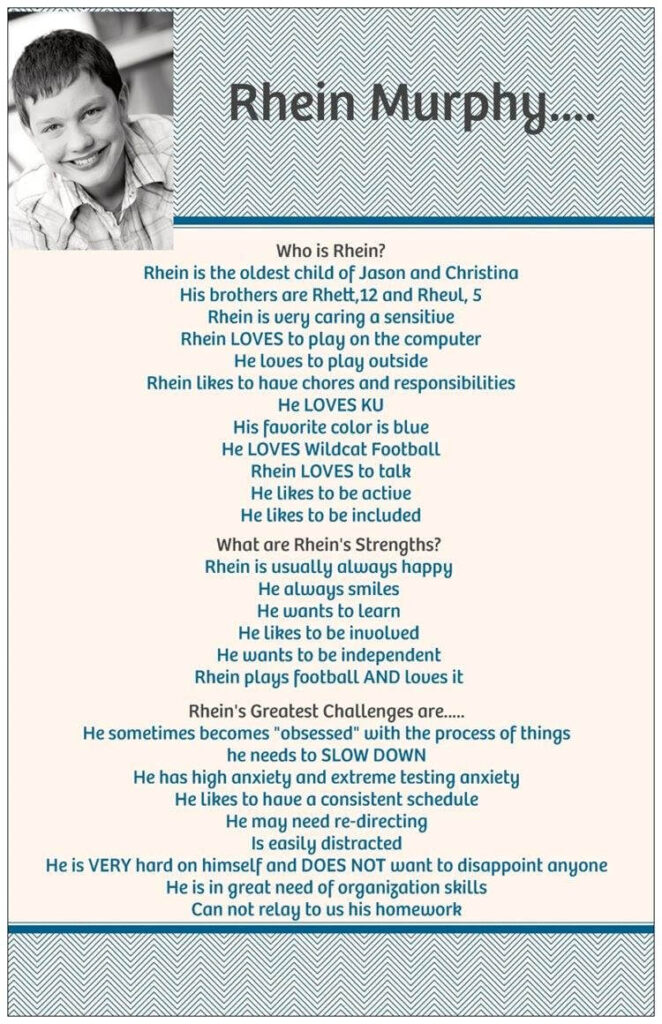
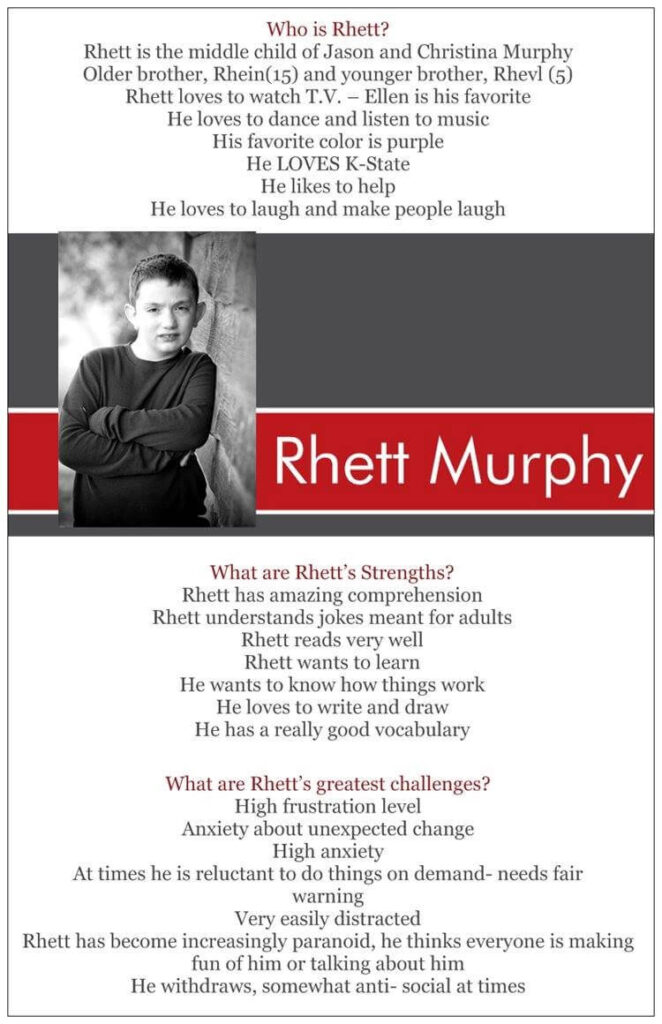
Tips From Parents
Tips for Meetings
“My input as a parent is really important in the IEP. So, I always write a detailed page for the “Parent Concerns” section. All year long I add bullet points to a document I keep on my computer. When something comes to mind — a particular challenge, a great success, a dream for him — I type a bullet point. Then when it’s time to write my part of the IEP, I have my bullets to refer to. I try to do my piece well in advance of the meeting in hopes that his teacher might use some of my thoughts to form the goals.”
“I always tried to act as another part of the whole team. I did things, I volunteered to provide things, and expected others to do the same. I never went in just pounding my fist and requesting unrealistic things. It has to be cohesive!”
“It never hurts to ask for something, the worst they can say is no.”
“Trust your gut.”
“Educate the IEP team on FXS and what you as the parent know about FXS learning styles each year.”
Tips for Food
“For every meeting (monthly or IEP) we bring food. Muffins, scones, cut up fruit-yogurt and paper bowls since we usually meet in the early morning. We know their dietary needs as well and provide something healthy. It lets them know that we care about them and appreciate their help.”
“I believe it’s a nice gesture AND it’s harder to say no with a bagel in your mouth. Pete suggests bringing enough so there is extra. Then when it’s in the teachers’ lounge and someone says, “Where’s this from?” the answer shows you’re generous parents as opposed to the talk in the teachers’ lounge being about your list of demands.”
“We bring food in as well. I always come in a few minutes early and stop in the front office and make sure the secretary and principal have some as well as anyone else on the team who may not be at the meeting (like the paraprofessionals!). These small gestures have always helped not just with IEPs but also throughout the year because they all KNOW me so when we have had to be firm about a decision, they understand a little better. They are also more likely to go out of their way for us 🙂.”
Related Resources
Assistive Technology and the IEP (PDF)
This article provides parents with useful information about AT and how to go about addressing it as part of their child’s IEP.
Understanding IEPs
From Understood for All, includes the purpose of an IEP, how to get an IEP, IEP meetings, and staying on top of an IEP.
IDEA Fact Sheet (PDF)
SMART IEPs
The term SMART IEPs describes IEPs that are specific, measurable, use action words, are realistic and relevant, and time-limited.
Special Education: Federal Laws vs. State Laws
From Understood for All, state laws can’t contradict IDEA, and they can’t provide less than the federal law requires. But they can offer more protections to kids and parents.
Find Your Parent Center
There are nearly 100 Parent Training and Information Centers (PTIs) and Community Parent Resource Centers (CPRCs) in the U.S. and territories.
American Speech-Language-Hearing Association (ASHA)
IEP resources including “Five Tips To Avoid IEP Legal Troubles” and “A Strengths-Based Approach to the IEP Process” (on-demand webinar).



